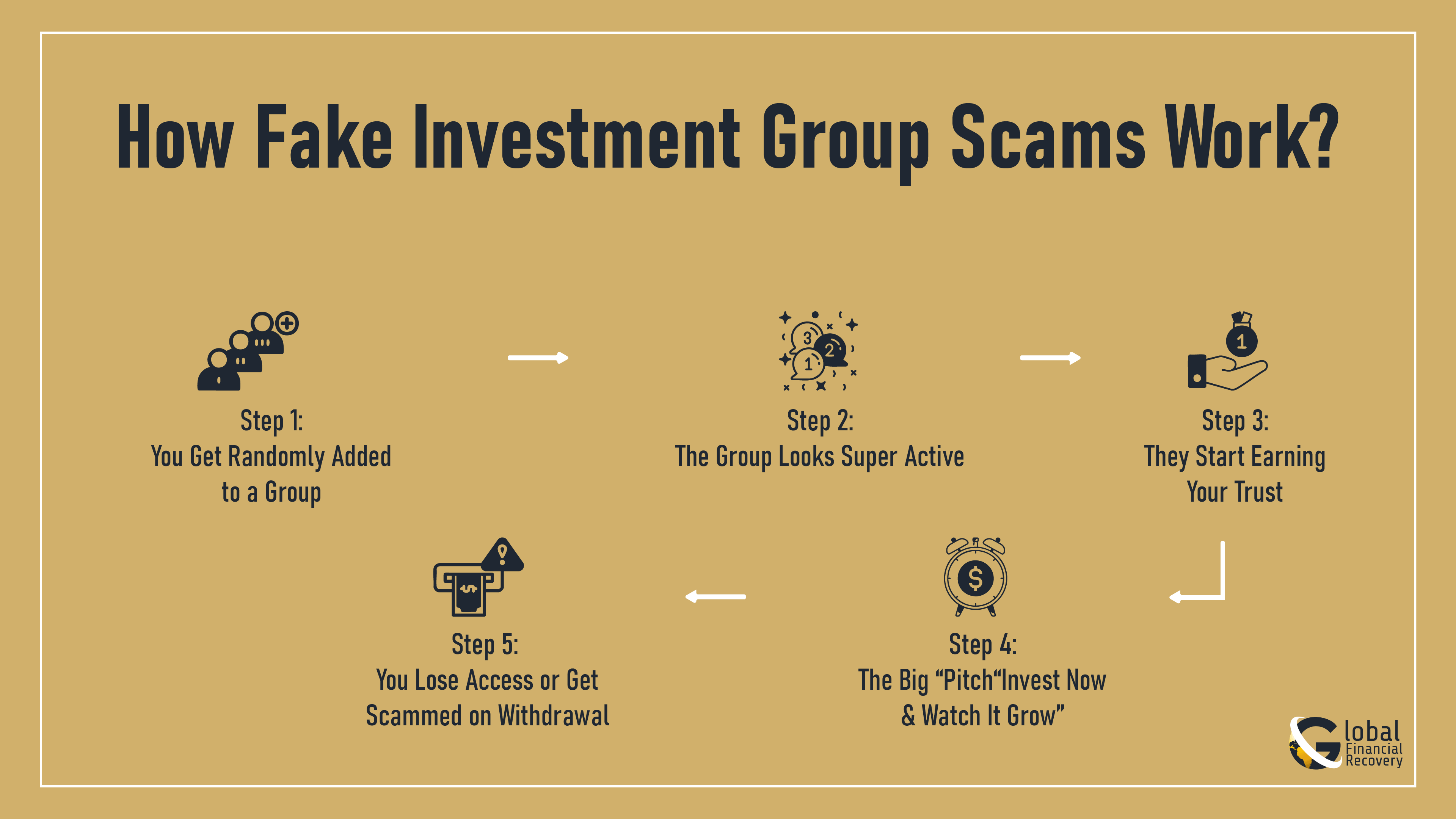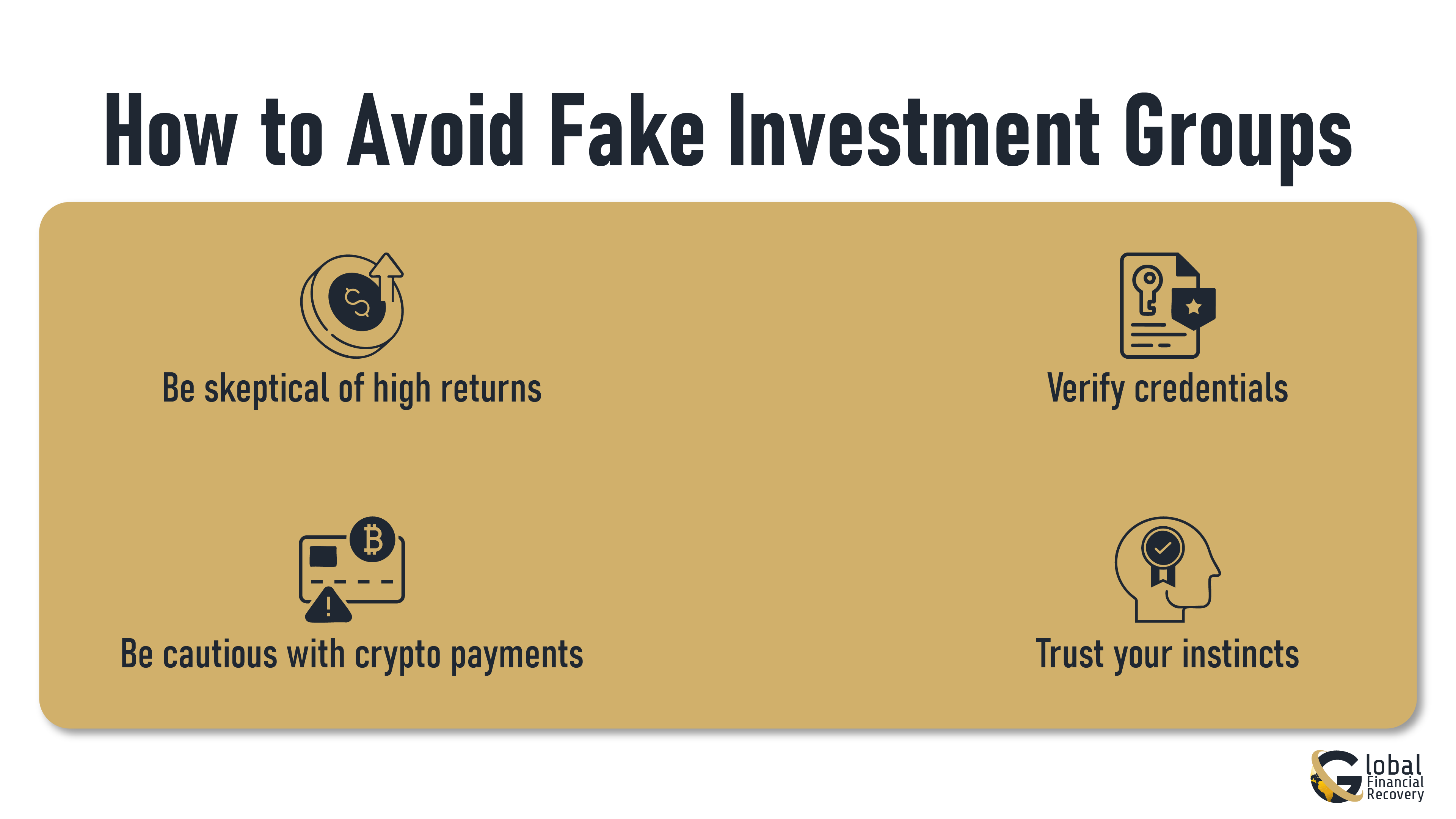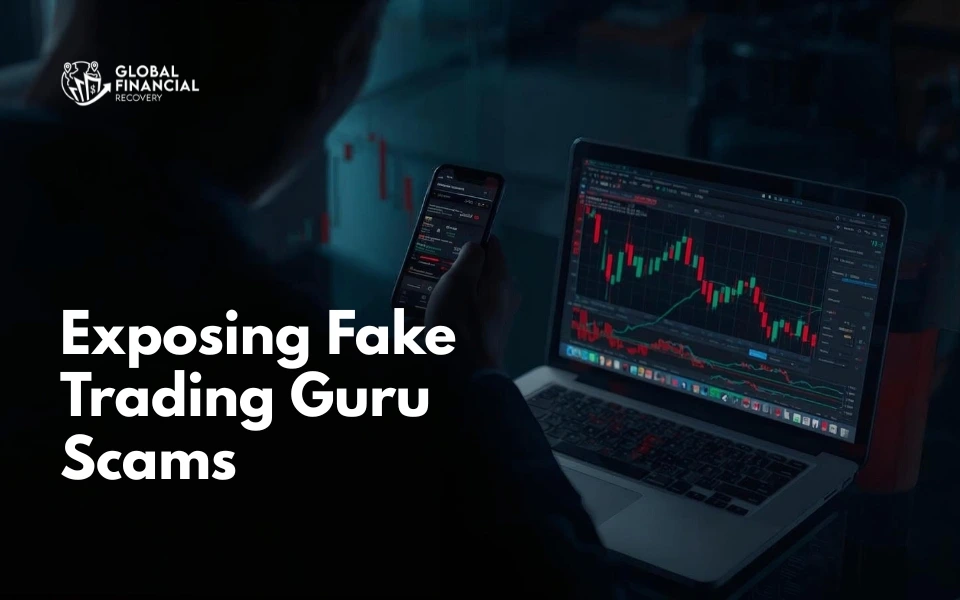
- Investments
- August 22, 2025
Table of Contents
Investment groups on platforms like Telegram, WhatsApp, and Discord seem like a great way to get tips, insider updates, or connect with other investors. But not all of these groups are what they seem. In recent years, scammers have been creating fake investment group chats to trick people into sending money. They often promise huge returns, insider tips, or “limited-time” investment opportunities.
Moreover, these scams are becoming more advanced and difficult to spot. What starts as a casual chat with like-minded investors can quickly turn into a carefully crafted trap. Victims are often added to fake groups filled with scripted messages, staged testimonials, and false trading results, all designed to build trust and push you into investing.
Different studies by the Federal Trade Commission (FTC) reveal that over fifty percent of victims of crypto scams had initially been targeted via social media or message applications.
If you've been targeted by one of these fake investment group scams, you're not alone, and recovery is possible. In this guide, we’ll break down how fake investment group scams work, their red flags, their examples, and how to protect and recover your funds.
What Are Fake Investment Group Scams?
Fake investment group scams are online frauds where scammers pose as a trusted group of investors. They often use platforms like Telegram, WhatsApp, Facebook, or Instagram to lure victims into fake investment opportunities.
At first glance, these groups look legitimate. You’ll see active chats, “members” posting profits, and admins sharing tips or market updates. But behind the scenes, the whole group is staged. The messages, results, and success stories are fake. Most of the participants are either scammers or bots designed to build your trust.
Once they have your attention, they pitch what looks like a great deal: a crypto trade, forex investment, or early access to a high-yield platform. You might even see others in the group claim they’ve made big profits already. But if you send money, you’ll either never get it back or you’ll be asked to “invest more” to access your funds, another layer of the scam.
These scams take advantage of emotions, particularly FOMO (fear of missing out), greed, and an emotional desire for financial freedom. They want you to act fast and silently, without thinking or asking too many questions.
How Scammers Use Group Chats to Manipulate Victims?
Scammers have gotten smarter. Instead of cold messages or spam emails, they now build entire fake communities to trick people into investing real money into fake platforms. These groups often present on Telegram, WhatsApp, Facebook, and Instagram, where it’s easy to add people and create the illusion of a buzzing investment hub.

At first glance, these group chats seem helpful and full of success stories. But dig a little deeper, and you’ll see it’s all smoke and mirrors.
Let’s walk through exactly how they pull this off step by step.
Step 1: You Get Randomly Added to a Group
It starts simply. You’re suddenly added to a group chat. Maybe by a stranger, or a profile that looks like a financial expert, or even a fake friend account. The group has a name like:
- “Crypto Trading Profits 2025”
- “Smart Investment Club”
- “Daily Passive Income”
- “Experts Share Stock Picks”
At first, you may be curious. It feels like you're getting access to some secret or insider space where real people are making real money. You scroll through… and everything looks surprisingly positive.
But what you don’t realize yet is that this is a setup. Most of the members are fake profiles. They’re all working together.
Step 2: The Group Looks Super Active (But It’s All Scripted)
Once inside the group, you’ll see tons of messages flying in. People are sharing:
- Huge profit screenshots
- “Thank you” messages to the group leader
- Advice on when to buy or sell
- Links to an investment platform that “changed their life”
It feels like an honest, thriving community. But it’s not. Most of the messages are pre-written scripts posted by fake accounts. The goal is to create social proof to make you feel like “everyone here is making money, so it must be real.” They’re faking momentum to make you lower your guard.
Step 3: They Start Earning Your Trust
Now comes the personal touch. One or two friendly “members” may send you a message directly. They’ll ask how you’re doing and if you’ve invested yet and say things like:
“I was unsure at first too, but it really worked for me.”
“The admin is super legit and helped me double my money in two weeks.”
These are scam actors pretending to be regular people. They’ll act kindly, patiently, and professionally. You might even feel like they genuinely want to help you grow your money. But this friendliness is all part of the trap. It’s meant to build trust and get you emotionally involved.
Step 4: The Big Pitch “Invest Now and Watch It Grow”
After you’ve been in the group for a while, the admin or someone else will send a message that sounds urgent but exciting:
“Last chance to invest before the market pumps!”
“Our new VIP signal just dropped, only for serious members.”
They’ll guide you to a fake investment platform, often a convincing-looking website or app. You’re asked to create an account and deposit a small amount, like $100 or $200. At first, everything looks good. Your “account” shows profits. Maybe you’re even able to withdraw a bit of money, just enough to earn your trust. But this is all staged. It’s a confidence trick to make you feel safe enough to invest more.
Step 5: You Lose Access or Get Scammed on Withdrawal
Once you deposit a bigger amount, maybe $500, $1,000, or more, the real scam kicks in.
Suddenly:
- You’re told you need to pay a “processing fee” to withdraw.
- Your account is “under review.”
- You’re asked to verify your identity… with more money.
- Or worst of all, you’re simply blocked from the group or app entirely.
By then, the group chat might go silent, or you may be removed from it completely. The scammers move on to their next victims.
Why Fake Investment Group Scams Work So Well?
These scams don’t feel like scams at first. That’s what makes them dangerous. They use fake social proof, peer pressure, and emotion to pull you in. When you see dozens of people celebrating their “success,” you’re more likely to believe it’s real. When a friendly stranger encourages you, you might feel safe to try it.
But the truth is, if a group is full of success stories, no real risks, and promises of fast profits, it’s almost certainly fake.
Common Warning Signs of Fake Investment Groups
Not every investment group online is real, and scammers are getting better at making things look convincing. But if you know what to look for, you can avoid falling into their trap.
Here’s a quick table to help you spot the most common red flags:
|
Red Flag |
What It Means |
Why It’s a Problem |
|
Too-Good-To-Be-True Returns |
Promises of huge or guaranteed profits like “Double your money in 24 hours” |
Real investments carry risk. Promised profits = likely scam. |
|
Exclusive or Invite-Only Access |
The group says it's private or only for “special members” |
This is just a trick to make the group feel trustworthy or important. |
|
Urgency and Pressure |
Messages like “Last chance!” or “Only 10 minutes left to invest.” |
Scammers rush you so you don’t have time to think or check facts. |
|
Anonymous or Unlicensed Admins |
Group leaders have no verified identity or public profiles |
Real investment pros are registered and transparent; scammers hide behind fake names. |
|
Requests for Crypto or Gift Cards |
You’re asked to pay using crypto, wire transfer, or gift cards |
These payment methods are untraceable. Once sent, it’s nearly impossible to get back. |
|
Deleted Questions or Blocked Members |
Questions get removed, or members who raise doubts are kicked out |
Scammers don’t want any doubts to spread; they want full control of the conversation. |
If you notice even one of these signs, take a step back. It’s always better to double-check than to lose your hard-earned money to a scam.
Who is Most at Risk?
Scammers don’t always target one specific group, but some people are more vulnerable than others. Here’s who they go after most:
|
At-Risk Group |
Why They’re Targeted |
|
Young adults (18–35) |
Comfortable with crypto, social apps, and online investing but may lack experience. |
|
Crypto Beginners |
Still learning how crypto works and may not know how to spot fake platforms or wallets. |
|
Retirees or older investors |
Often looking for safe investments or ways to grow retirement funds. |
|
Immigrants & international workers |
May face language barriers or financial pressure and trust community-based groups. |
|
People in financial stress |
More likely to take risks if they’re desperate for fast returns or extra income. |
How to Avoid Fake Investment Group Scams?
It all comes down to one thing to keep you safe: caution. Scammers are clever, but you can still safeguard yourself by asking the appropriate questions before you invest.
Be extra cautious if you are added to a group via social media platforms like Telegram, WhatsApp, or Facebook. If profit appears to be generated quickly or they say “guaranteed returns”, that is a huge warning sign. Real investments do not promise things.

Further, make sure to always check if the person giving advice on the investment is licensed. You can check them out on trusted sites like Investor.gov or FINRA BrokerCheck.
In addition, if they ask you to invest through an app or website, do your research first. Many fake platforms look professional but are not real or regulated.
Also, be cautious if they ask for crypto payments or wire transfers. These are harder to trace and are often used in scams. A real company will let you pay through safe, normal banking channels.
Watch how the group behaves too. If everyone is always happy and talking about big profits, something’s off. Real groups have honest talks, not just fake praise and success stories.
And finally, don’t rush. Just because others in the group are jumping in doesn’t mean you should. Take your time. Ask questions. If something feels wrong, step away. When it comes to your money, it’s okay to slow down.
Don’t Let a Group Chat Decide Your Financial Future
If you’ve made it this far, you’ve done something most people haven’t. You’ve taken the time to learn before it’s too late. That alone puts you in a stronger place. Now, you can spot the tricks before they work on you.
Fake investment group scams are more than just a small risk. They’re part of a bigger system of online fraud. Scams are designed to exploit your trust, hope, and greed to grow your money. But when you stay aware, ask questions, and take your time, you not only protect your money but your peace of mind as well.
And if you have been scammed? You’re not the first. It doesn’t mean you are careless; it means you are human. The scams are run by people who know how human emotion works and exploit that to their advantage.
Think you have been scammed?
Take the guidance of reliable financial fraud recovery experts such as Global Financial Recovery, and we'll help victims who’ve lost money in crypto or online investment scams.
FAQs (Frequently Asked Questions)
They use bots or multiple fake accounts to fill the chat with comments, praise, and fake success stories. These messages are posted regularly to keep the chat looking busy and positive.
Because the setup feels real. The group looks active, people seem to be making money, and admins are helpful. Scammers use these tactics to lower your guard and rush you into sending money.
Yes. These platforms are magnets for scammers because they enable rapid communication and easy group creation. A lot of victims say that their contact was initially made via apps like Telegram, WhatsApp, or Facebook Messenger.
Absolutely. Scammers edit pictures to display false trading gains, crypto transfer, and even false support chats. These images are all part of their scheme to gain your trust and get you to believe the platform exists.
Cut off all communication with the scammer. Screenshot all messages, payment verification, and usernames. Save everything. Finally, report the scam to the platform (Telegram, WhatsApp, etc.) and report it to the FTC, IC3.gov, or local cybercrime unit.





